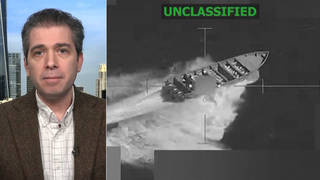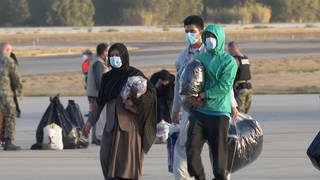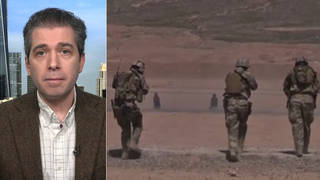
We get an update on the Donbas region of Ukraine, where Russian forces are now focused. Russia has backed a separatist movement in the Donbas since 2014 and used protecting the Russian-speaking population there as a justification for its invasion in February. We speak with Brian Milakovsky, who lived in the Donbas town of Severodonetsk before he evacuated to Croatia in January and is now fundraising for people trying to flee Russian attacks. The Russian obsession with annexing the Donbas region is part of a “fanatical belief that the East really must be actually a part of Russia,” says Milakovsky. “They’re leveling these cities,” and “it’s not really clear for what purpose except for bolstering their own narrative,” he adds.
Transcript
AMY GOODMAN: This is Democracy Now! I’m Amy Goodman, with Nermeen Shaikh.
In eastern Ukraine, fighting is continuing along a 300-mile frontline. The governor of Luhansk says Russia now controls 80% of the region. Luhansk is one of two regions that make up the Donbas in eastern Ukraine.
For more, we go to Brian Milakovsky, expert in economic recovery in eastern Ukraine who’s also helping raise funds for evacuations from Donbas. He’s joining us from Croatia. Until January, he lived in the Donbas.
Welcome to Democracy Now! Can you talk about the conditions there, the strategic importance of this area and what a war of attrition means in the Donbas?
BRIAN MILAKOVSKY: Yes. Thank you. Thank you for having me.
Conditions are really horrifying. Looking through my smartphone at what’s going on in the city where I’ve been living the last six years, where I was married, started a family and have been working, Severodonetsk, which is the temporary capital of Luhansk Oblast, while Luhansk itself has been under Russian control since 2014 — looking through my smartphone at what’s happening, it really looks like a post-apocalyptic video game. It’s horrifying that these kinds of conditions are possible to reach, especially in such a short time. I mean, I think many people have seen that Mariupol, a much larger city, has been basically turned to a charred ruin. Places like Severodonetsk are in a somewhat earlier stage, but nonetheless it’s just almost — virtually every one of these classic Soviet apartment blocks is scarred by multiple direct hits. Huge fires would burn up the sides of these buildings, you know, charring them black. There’s almost not a single public object in the city that I was living in that hasn’t been severely damaged.
And the strategic value of a place like Severodonetsk, if we were to compare it to Mariupol — right? — which is located along the Azov Sea coast, where — you know, between Russia and the occupied Crimean Peninsula — Mariupol, I think, really has strategic, certain amount of value as part of Russia’s invasion. I really think seizing places like Severodonetsk or Kramatorsk, another large eastern city that the government currently controls, is really primarily symbolic for Putin and Russia. It’s this belief they have, fanatical belief, that the east really must be actually a part of Russia.
And that’s what’s so horrifying, is that they’re leveling these cities, without, A, that basis of support that they thought was there. They really believed they’d be met, as Russians and Ukrainians say, with bread and salt. And they’re leveling these cities in order to, instead, you know, forcibly take them away, and then it’s not really clear for what purpose, except boistering their own narrative. And they will not have the resources at all, under such intense sanctions and with oil embargoes going on, to do anything with territories they’re trying to seize. So, of course, those of us who were living in the east really pray that, even with all this destruction, it remains under Ukrainian control.
NERMEEN SHAIKH: Brian, could you talk about the situation in Donbas since 2014? I mean, it’s hardly been a peaceful place. According to the U.N., 14,000 people have been killed on both sides.
BRIAN MILAKOVSKY: Yes, about 3,500 of whom were civilians. We really need to remember what a toll there was on civilians in the region.
I only lived and worked in the government-controlled areas. It’s often forgotten that 60% of the Donbas remains, until this war began, under the control of the Ukrainian government. And what I would say is, it took an enormous socioeconomic blow in 2014, severed commercial relations, value chains, and severed personal and family ties. It was an enormous tragedy to see the region cut in two when Russia launched its separatist project that led to Donetsk, Luhansk and other major cities coming under Russian and separatist control.
But in the government-controlled areas in this sort of space over the last seven to eight years, there was a reasonable recovery. I’ve been working in humanitarian and development work during that time. There was — you know, decentralization by the Ukrainian government led to significant improvements, actually, in the quality of urban spaces in these places. There was a diversification in the business community, in end markets they were working on, a slow but precious recovery, which is being obliterated by this war. And that’s, of course — that’s really difficult to watch, because it was so important that the part of the Donbas under government control was stabilizing, and you could see the framework of a pretty good economic future slowly being built there after the shock of 2014. And really, we’re just seeing that be obliterated before our eyes.
AMY GOODMAN: Brian, we’re going to do Part 2 of this discussion and post it at democracynow.org. But, very quickly — we have 30 seconds — if you can talk about the civilian-led effort of evacuation that you’re helping to lead right now from the Donbas?
BRIAN MILAKOVSKY: So, Ukrainian volunteers are getting thousands of people out in school buses, delivery vans, compact cars. It’s an entirely civilian-led intervention, volunteer-led, no big organizations involved in this for the time being. But we’ve got out more than 8,000 people so far through this means, mostly from Luhansk Oblast. People who are interested in that can find out more about how I gather donations for that on my Facebook page, Brian Milakovsky. But this is really work being done by extraordinary Ukrainian volunteers, who gained experience in 2014 with exactly this kind of disaster.
AMY GOODMAN: Well, we want to thank you for being with us, Brian Milakovsky, expert in economic recovery in eastern Ukraine, who until January lived in Severodonetsk in Ukraine — that’s in the Donbas — helping raise funds for evacuations now from the Donbas.
That does it for our show. Democracy Now! has an immediate opening for a news writer/producer. Visit democracynow.org/jobs to find out more and apply.
Democracy Now! is produced with Renée Feltz, Mike Burke, Messiah Rhodes, Nermeen Shaikh, María Taracena, Tami Woronoff, Camille Baker, Charina Nadura, Sam Alcoff, Tey-Marie Astudillo, John Hamilton. I’m Amy Goodman, with Nermeen Shaikh. Stay safe.











Media Options